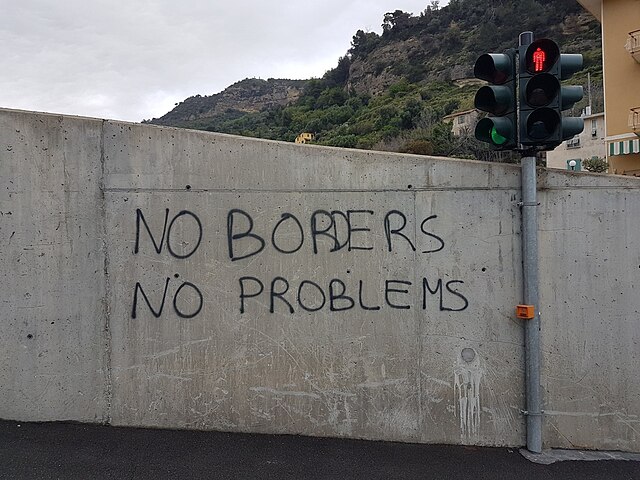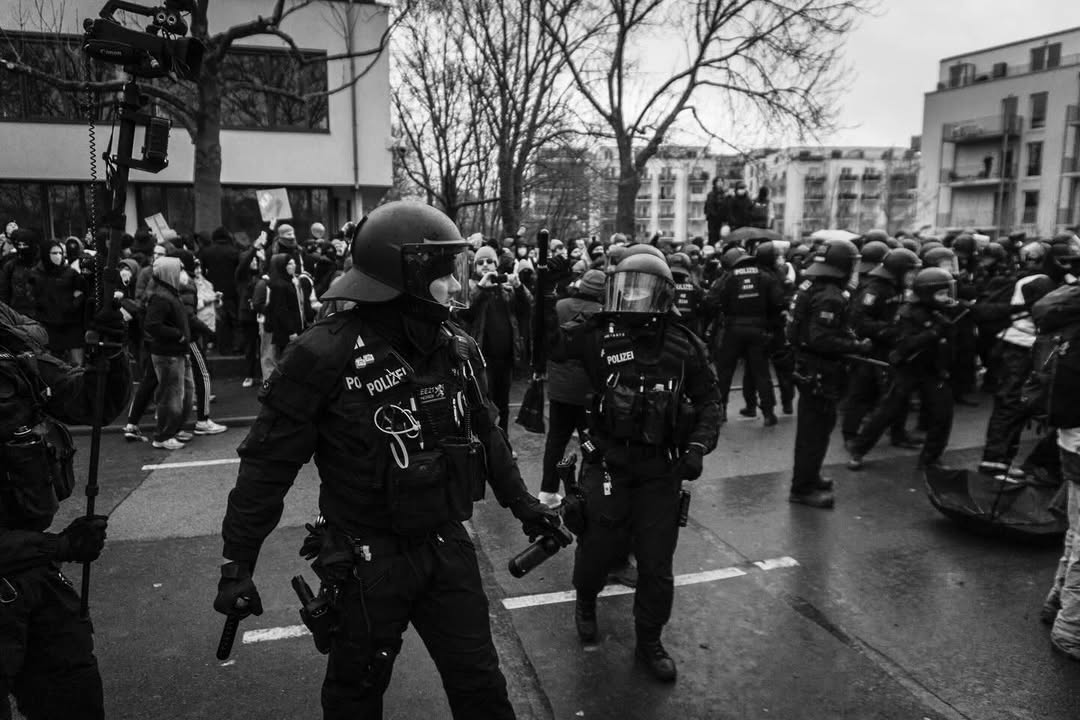From Mette Fredriksen to Sahra Wagenknecht to (now) Bernie Sanders, the broad consensus parts of the Western ‘Left’ appears to have converged at leftist praxis that protects domestic labour through controlling migration. In Europe, Denmark’s Mette Fredriksen’s explicit pro-labour, anti-migrant positioning has been a source of inspiration across the continent, not least to Germany’s own Sahra Wagenknecht. In America, Bernie Sanders’ political opinions appear to have shifted back to an anti-migrant baseline, now that the broader Democratic establishment has grown less attached to signalling anti-racism.
At its core, this consensus frames migration as a phenomenon encouraged by cynical neoliberals trying to bring down wages by relying on an infinite reserve army of labour in the global South. These neolib demons, by leveraging visa precarity and threats of deportation, ensure that migrants cannot participate in wage struggles or switch jobs as easily as citizens can, proliferating immiseration. The only solution to this, these ‘leftists’ claim, is border controls—both to maintain domestic labour’s capacity for wage negotiation, and to quell the surge of the far-right. The specificities of what these controls imply differ, in particular given the refugee/migrant distinction—featuring a spectrum of desirability, from refugees at the bottom to well-compensated, ‘highly skilled’ workers at the top.
While the recent escalation in anti-migrant discourse can in large part be explained by the far-right’s obsession with anti-migrant ‘culture wars’, it is also rooted in history. Both European and American workers’ movements have always involved a strong xenophobic component. Calls for migration bans on East Asians was a cornerstone of what Lenin called jingo-socialist labour organising in 20th century America. In post-War Britain, the predominantly white labour movement colluded with their employers to shut off employment for black and Asian migrant workers from the Empire. In Germany, trade unions and works councils were closed off to representation from the Gastarbeiter that drove the Wirtschaftswunder. The xenophobia that we see today should be seen in this light —as a modern resurgence of an undercurrent that has always existed, once more on the rise—the aftermath of numerous migration crises that Western interventionism has contributed to, all against a backdrop of two decades of near-global capitalist stagnation.
***
Let’s steelman the anti-migrant-left position, giving it as charitable an interpretation as possible. This position would hold that migrant workers are brutally exploited (in a moral sense), and that the best way to transcend global capitalism is to build worker solidarity across countries. Through building strong unions at home, Northern workers could help their southern counterparts; eventually, a global labour movement would eliminate the necessity for migration. Keeping migrant workers at bay in the meantime makes this dream easier to achieve, since a smaller reserve army of labour would lead to less reaction and less division within domestic workers’ movements. To their credit, the left end of this position tends to be sympathetic to refugees fleeing war.
This framing appears reasonable on the surface; yet one need not dig deep to demystify this rhetoric and unearth the jingo-socialism that lies beneath.
Critics of neoliberalism (or of capitalism writ large) aren’t incorrect about migration’s utility to the accumulation of capital. Through maintaining visa precarity, neolib demons are indeed able to control, filter and utilise streams of migration that best suit accumulation, all the while ensuring that labour has minimal capacity to negotiate for better conditions. But the reason that the ‘acceptable’ response to this on the left has been to adopt the right’s clearly anti-universalist and supremacist rhetoric—rather than to unwaveringly maintain commitments to open borders—lies in the extent to which nation-states have been reified in the public consciousness. The result of this reification has been that exclusion along the lines of nationality appears far more acceptable (natural, even) than other forms of discrimination. Thus, nation-states are seen as inevitable; as a “reasonable” and “correct” way of dividing the world, unlike other divisions like race or religion or caste or gender. It may be easier to imagine the end of the world than the end of capitalism; but to many, it appears the end of the nation-state is even harder to imagine.
Along with casting these nation-states as ‘natural’, this reification involves framing them as independent units, as subdivisions of the map, all unrelated to one another. Each nation-state features its own domestic relations of production, its own independent path towards a post-capitalist future. This framing goes back to the origins of nation-states, deeply co-constituted with the inception of capitalism, and to the alienation of producers from the means of production. Nation-states and nationalism played the role of a sentimental veil, obscuring this alienation and the exploitation of labour, through the artificial construction of a shared solidarity across class lines. Yet capitalism today, as Chris Harman reminds us, finds even the biggest existing states too small for its operations. Nation-states must follow the imperatives of the world market, and must engage in constant cycles of trade. To start from the assumption that they are independent producers is only marginally less naive than the market-fundamentalist assumption that individuals are independent producers. It is a rejection of the idea of the socialisation of labour under capitalism — of the transformation of production and distribution into an increasingly social activity, all over the world market.
The existence of global trade serves to explain the particular framing around migration that exists in the global North. None of this is to say that the rest of the world does not have anti-migration movements; it does, and features both border regimes and armed mobs that do not hesitate to kill. But there is a reason the precise framing of ‘defending labour’ is so effective in the North. The postcolonial period has been characterised by immense mobility for Northern capital, allowing the bourgeoisie to obtain resource and labour inputs from the South, driving up the domestic rate of profit. Unprecedented restrictions on the mobility of labour, on the other hand, make it next to impossible for labour to move to regions with higher concentrations of capital and higher wages. These dynamics effectively cement increasing divergence between Northern and Southern growth into place, fuelling both Northern growth and consumption, and creating the possibility for a compromise between labour and capital in the North. This is not (just) out of malice, or racism; it is simply how capital functions given the vast spatial inequalities that characterise modernity.
Perhaps this is the reason that so many workers in the Western world are driven to reaction. Perhaps they recognise that borders work in their interests: foreigners out, profits in, and hopefully compromise somewhere down the line. This is undoubtedly a massive impediment to building international solidarity and class struggle. But if class struggle today has been superseded by national struggle, perhaps open borders are precisely the antidote that is needed — to force the workers that today hide behind modernity’s strongest sentimental veil to develop genuine class consciousness, and to recognise themselves as workers.
***
When Bernie Sanders calls for migration curbs on ‘dog trainers and English teachers’, or Mette Fredriksen takes issue with ‘welders from India or Bangladesh‘, they are talking about low-wage workers (even though Sanders is slightly detached from reality when he conflates this with H1Bs, who span the entire spectrum of wage labour). High-wage migrants continue to play a slightly different role in migration discourse, and politicians—neoliberal or otherwise—tend to be a lot quieter about their continued migration. Once again, this is so the processes of the accumulation of capital continue unabated; the ‘right sort’ of migrant, educated and well-compensated, can help produce the technical know-how and the intangible commodities that drive so much Western capitalism today. The same states that resort to ‘Fortress Europe’ rhetoric for refugees and ‘economic migrants’ silently compete to attract high-wage labour—the Nordic countries and Germany relax permanent residence requirements on the basis of wage; the UK has special visas for ‘high potential individuals’; the US retains its EB1 category for precisely this sort of labour.
Today, it is clear to those with eyes to see that capitalism has entered a period of deep malaise; perhaps it has entirely run out of steam. Migration policies, in prioritising tax revenue (and therefore wage), end up prioritising the non-productive fields of finance and marketing, or the tech sector—a field that has grown increasingly parasitic, centred around building data enclosures, or platforms that serve little purpose other than to act as profit-absorbing middlemen. As a consequence of this, not only has the gap between labour and capital widened, but also that between labour and labour. Small wonder, then, that we see clashes between odious capitalists like Elon Musk and his former henchmen when it comes to precisely this high-wage migration. Nationalism’s sentimental veil does not discriminate between ‘good’ and ‘bad’ migrants, as much as capitalists (and many migrants) would wish for it to do so. And in periods of crisis, crisis itself becomes personified along the lines of migration status and ethnicity. The violence required to maintain the comfort of the veil resurges—precisely as we are witnessing today.
Migrant workers are, at the end of the day, human beings that have agency. When they choose to move to the west to be exploited by Western capitalists, they are doing so because it is often because it is their only viable shot at an improved standard of living. We must recognise this, and commit to building genuine workers’ internationalism, rather than wallowing in parochialism and the nation-state fetish. A left that abandons labour, wherever it may be, is no left at all. We must maintain our commitment to the emancipation of the workers of the world, and not just those of the wealthiest and most developed nation-states. This commitment may well mean an entire generation of complete electoral defeat for the left—but it is far better to accept this defeat, work on educating the masses and build hegemony than it is to renege on the freedom of movement and throw the workers of the global South under the bus. The most that this will ever achieve is a deeply chauvinistic state-capitalism at home, inextricably intertwined with the militarised borders that enclose the National Bolshevist fantasies of large chunks of the Western left.




